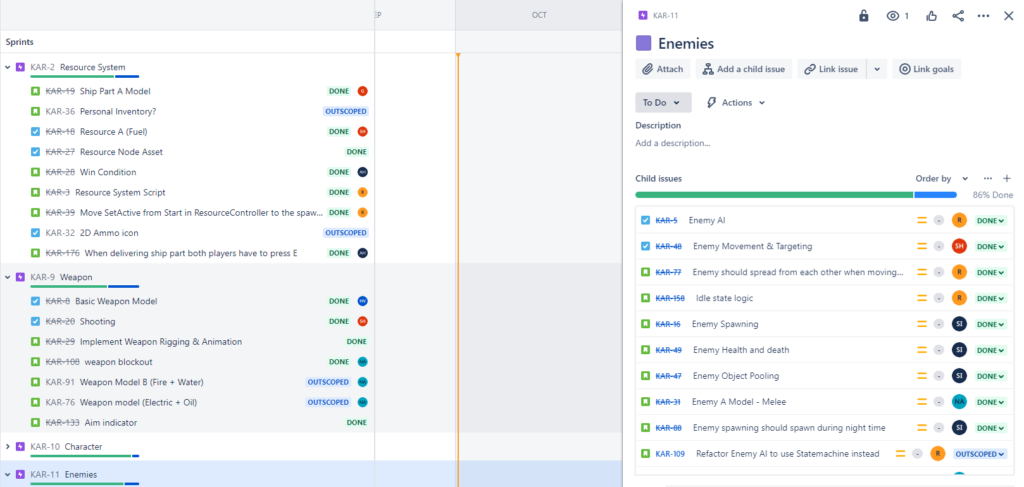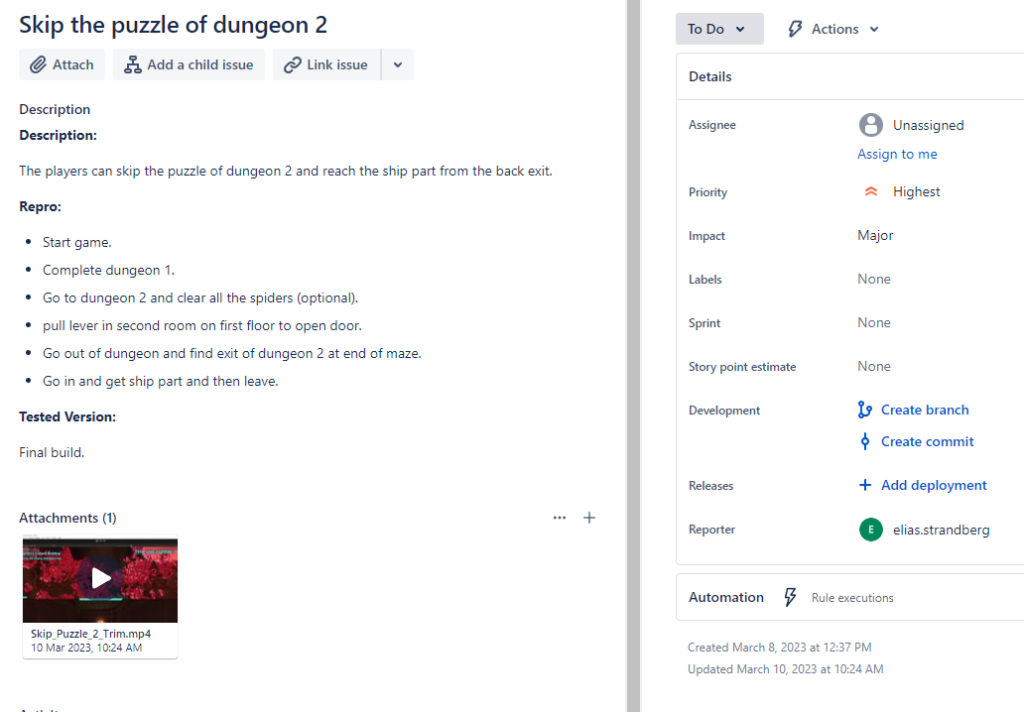Overview
Jimbo & Dimbo Space Adventure is a 2 player co-op FPS adventure game where your task is to repair your broken ship by finding the ship parts that has been lost. With a day & night cycle you have to spend the days exploring the area to find your ship parts, and the nights to defend your ship from attacking robot spiders.
This was our 2nd Game Project at Futuregames. I worked as a Product Owner, Gameplay Designer and filled in roles like Sound Design and UI.
Gameplay and UI Design
During the brainstorming session we had together with the programmers we discussed how we could play with the theme of Symbiosis, the players being dependent on each other in a way. In the midst of talking about each player having unique weapons I suggested the mechanic of that each player could stand on their own, although less efficiently, but together the players could combine their weapons to have greater effects.
Player one would have a weapon with fire bullet as their damaging projectile. And shooting water as their utility tool.
Player two would have a weapon with electric bullet as their damaging projectile. And shooting oil as their utility tool.
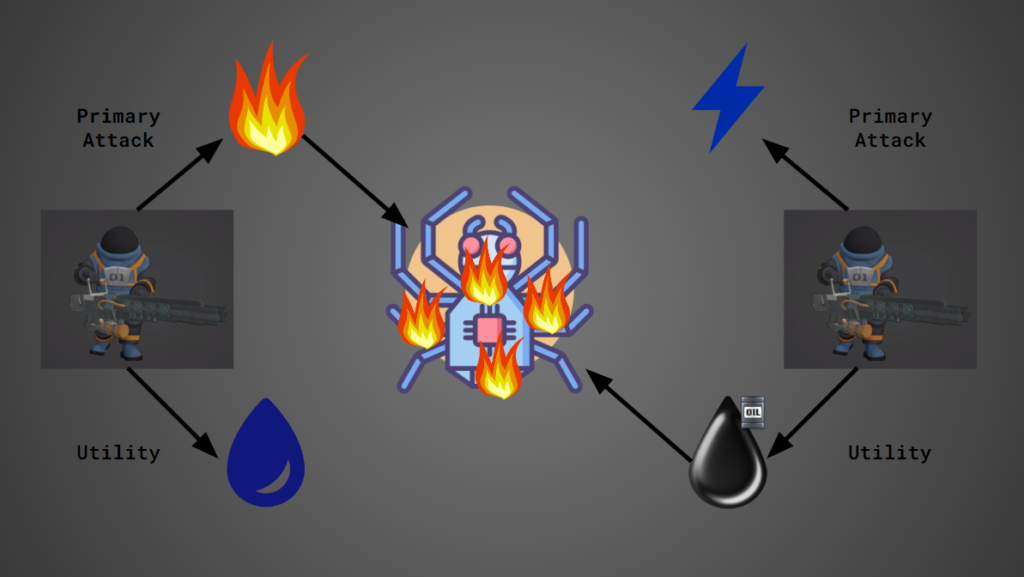
By shooting oil at enemies first and later shooting them with fire bullets would cause a Damage of Time effect in a small area. Making it easier to deal damage to enemies in a group.
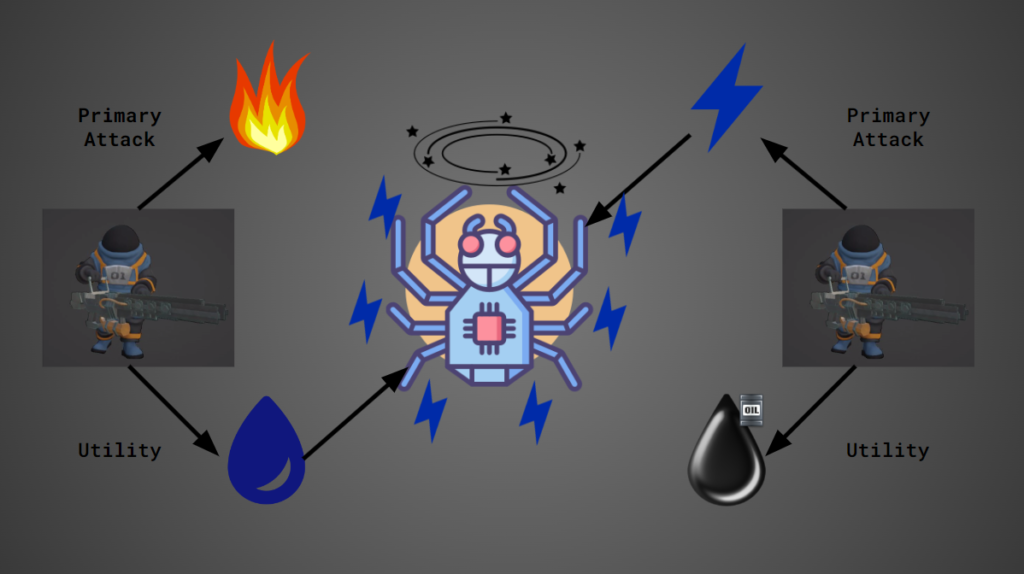
By shooting water at enemies first and later shooting them with electric bullets would deal a single increased damage on first bullet hit. It would also stun the enemy hit for a short time. Using this combo can help ease up the pressure when enemies are chasing one player.
AI Behavior
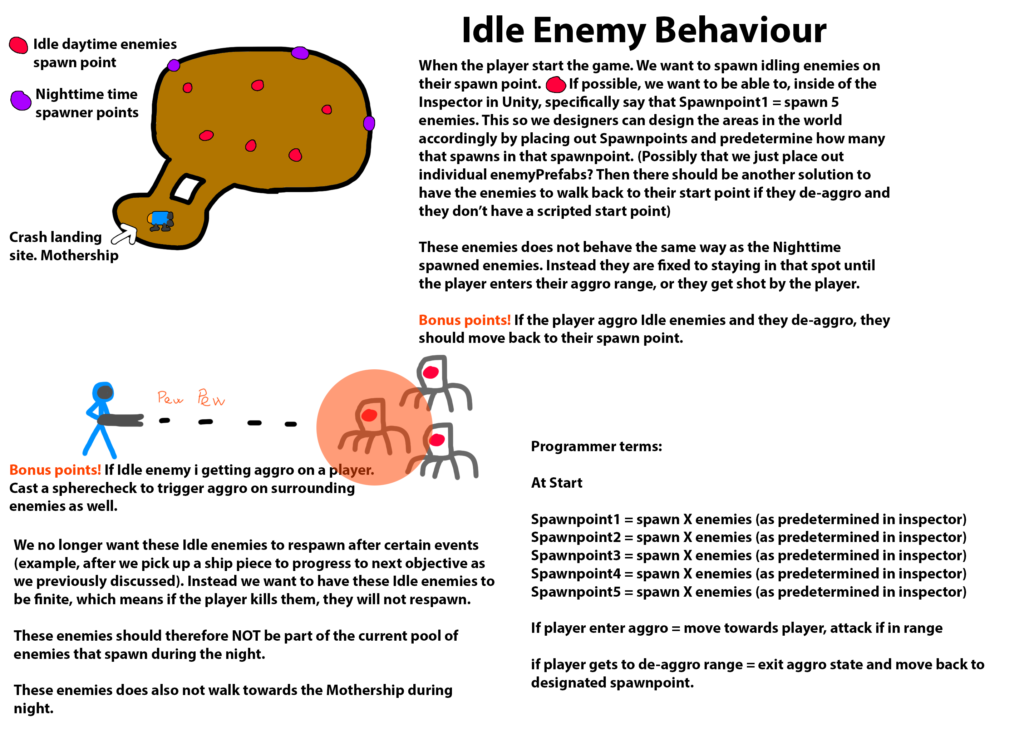
Utilizing imagery and psuedocode I designed the different behaviors of our two separate enemy types. Working like this made it possible to convey how the behavior should work technically without having as much experience in programmer as our dedicated programmers.
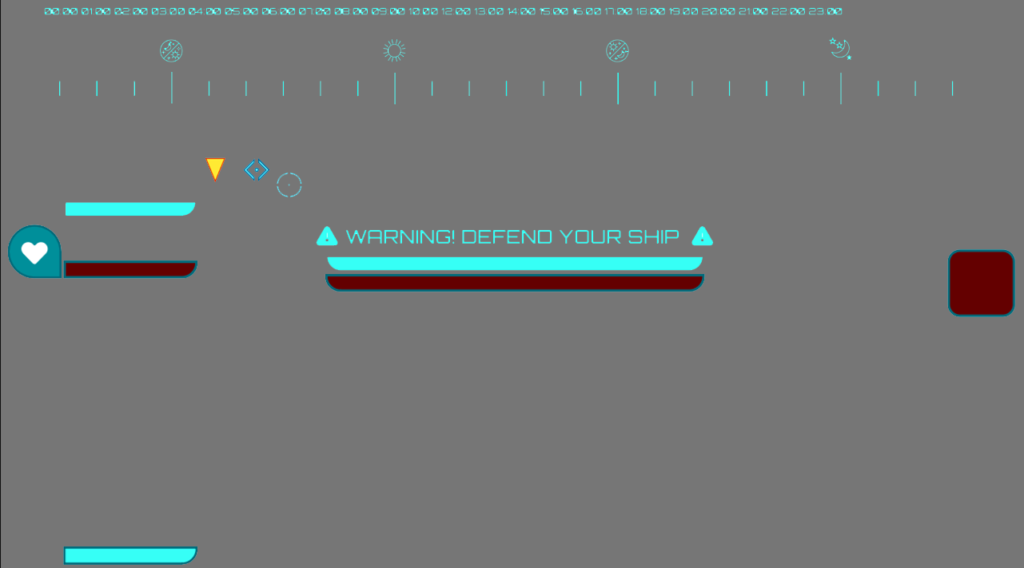
UI Assets including unused day and night cycle UI that could not be implemented in time.

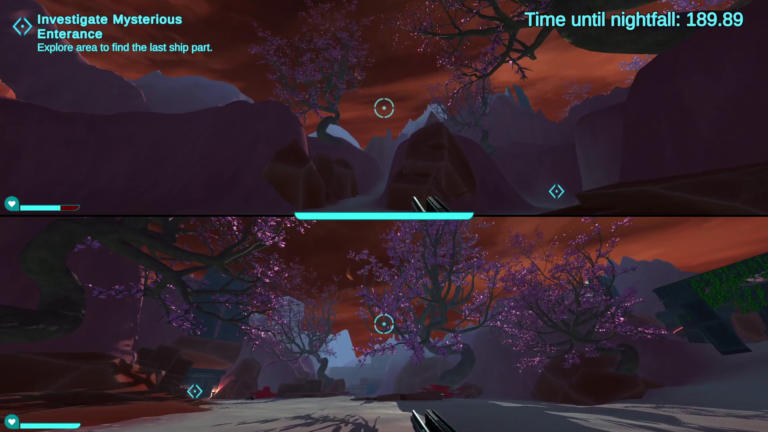

My goal with the UI was to make it contrast with the environment of the game for the sake of visibility. The world we are in consists of red and dark tones, so I went with a UI that was bright and with a color that fits with the slightly washed out feel of the colors. The UI was implemented with our progression system, and I would’ve liked to improve it with more animations and sound cues to make them communicate better to the player.
Agile & Scrum
Together with our Scrum Master I overlooked the tasks on the sprints to see we were meeting our goals for the deadlines. Continuously communicating with the team to update the sprint with tasks from the backlog. During sprint building we also included the whole team to rapidly create and assign tasks by letting each person have a say in what they wanted to work on and what they believed was high priority to add into the earlier sprints.
We made sure that our Jira was well categorized with each tasks being within their designated category. I was sure to remind and encourage to update their tasks, especially for when they needed review. This allowed me to either test out a feature or mechanic or make sure that needed art assets has been implemented before putting it as “Done”.
Thanks to our mentor Ali Farha he helped me setup a highly editable and easy to understand bug reporting format that we used with good results.
My role as Product Owner
Working in production in any field is never without any sort of problems. This project was nothing different. And each of them revolves different fields as well as different persons. And thus you have to tackle them different as well.
To give a small summarize of what strategies I’ve used to help and support my team members:
- Enabling a problem solving process by letting person grappling with an issue to perform a self-analysis.
- Sit back and listen to the persons concerns about a project decisions before engaging in reasoning to arrive at a mutually satisfactory conclusion.
- Facilitating someone’s expertise and empower them through collaboration and playful challenges.
Solving animation issues with self-analysis
One specific instance involved collaborating with an artist who encountered difficulties with animations, leading to growing frustration during work. In response, I offered my assistance by delving into the animation issue and encouraging the artist to guide and instruct me on their logical approach to the problem.
Through the process, the artist ultimately identified and implemented the solution independently, guided by a simple question such as, “How would you approach wrist rotation and ensure that the weapon follows the wrist’s angle?”
Resolving conflicts
During a team meeting, I brought up the importance of collaborative decision-making within our project. I advocated that no concrete decisions that would affect anything in the production should be made without involving the Product Owner, referring to examples where spontaneous and individual decision making could clash with prior agreements from the team.
After the the meeting, the involved individual requested a private conversation with me. During this discussion, they conveyed their feelings of being hurt and anger regarding my public statement. I attentively listened to their perspective, acknowledging their emotions, and empathized with their point of view. However, I also emphasized the necessity of structured decision-making processes for the benefit of the team and project. Throughout the discussion, we reached a mutual understanding.
The conversation concluded with the team member expressing their gratitude for taking the moment for them to vent.
Facilitating someone's expertise and empower them through collaboration and playful challenges.
A tactic I’ve used many times in previous work experience is to lowball my tasks to a co-worker, but add in “optional” additions as challenges to the task. In this way, I’m giving them an MVP requirement to pursue that I normally would be fine with being presented to me. However, that would require them to come to me and ask for more tasks, resulting in interrupting my own workflow. Instead, in this way I give the person room to not get pressured by a big task, but also gamify the process by giving them “bonus” tasks for them to pursue without having them come to me again. This also empowers the person to take initiative to go that extra mile and not settle for less.
Our Technical Designer was working very efficiently and they quite often ended up coming over to my desk to mention that they are done with their tasks and would ask what else is needed for the sprint. I knew prior of their expertise and utilized this tactic with them since I knew that I would end up collabing with them since I would be working on the UI art in the end of the project. And to give an example of how I discussed with them:
“We need a UI element where the players can see each other when they move too far away from each other. It should be rendered for both players camera at all time. But if you can make it so that the UI only appears when they are, let’s say 10 meters away from each other, that would be even better!”
Summary of My Contributions
- Product Owner
- Guided the team to follow the vision of the game project
- Assisted the Scrum Master in overlooking and alter the Jira Board based on performance.
- Helped problem-solving any issue occurred.
- Collaborated with each department to oversee progress to ensure goals were met.
- Preparing presentations.
- Gameplay Design
- Designed the core combat mechanics of the player characters.
- Designed enemy AI behavior.
- Designed the gameplay loop.
- Filled in roles to finish the project
- Sound Design
- UI Art
- Assisting Level Design
Mistakes and challenges
Playtesting Difficulties
With the project required to be 2-player coop we found it really challenging to playtest the features. As well as we have decided to have a first person perspective with weaponry required some precision and timing with 2 controllers to be able to test out some of the features.
Since all other teams also had the same requirements it was less attractive to sacrifice 2 resources of all teams to playtest other games. Which made it really difficult to gather valuable feedback.
Overscoping
This being our second game project at school we were happy to have a few more weeks to build our project compared to our first.
This ended up with us having big visions when we saw how fast we progressed during our first week. We saw the possibilities that the game could be. Evidently, it became too much.
We managed to push in all the features and mechanics we wanted. But with it the polishing suffered. The jury members wanted more clarity and combat feedback than we managed to put in. As well as they did not feel that we fully fulfilled the requirement of the theme, Symbiosis.
Reflection
Having worked as a producer in other fields helped me tackle this role with confidence. However, the terminologies and work procedures were new and different. I had never heard about Scrum before I started applying to Futuregames. I might have used my roles differently than what the industry expects from a Product Owner vs Producer. But I felt that my leadership style of being less “by the book” helped the team strive for something great as well as being able to quickly adapt .
Despite the difficulties, I’m very proud of what my team and me managed to build in just 4 weeks.
